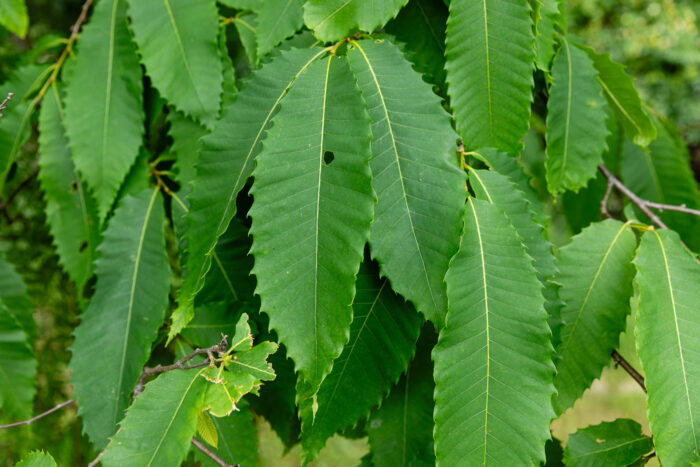American Chestnut
Castanea dentata
The American chestnut was once an abundant native tree that could grow 100 feet tall. Now, threatened by disease, the tree rarely makes it to maturity.
This section shows one large critter image at a time. Use the thumbnails that follow to select a specific image to display here.

This gallery contains a grid of small thumbnails. Selecting a thumbnail will change the main image in the preceding section.
Appearance
The American chestnut has long, canoe-shaped leaves with a prominent lance-shaped tip and hooked teeth around the edges of the leaf. The leaf is dull or “matte” instead of shiny or waxy in texture. American chestnut leaves are long in comparison to their width, and the stems usually have a reddish color.
Predators
The American chestnut is threatened by two diseases, Cryphonectria parasitica (the chestnut blight) and Phytophthora cinnamomi. American chestnuts also have several nonnative insect pests:
- Asian gall wasp, which impacts flowering and growth
- Asiatic oak weevil, which defoliates trees and feeds on roots
- Spongy moth (previously known as the gypsy moth), a defoliator of many broadleaf trees.
Reproduction and life cycle
Flowering American chestnut trees will either have only male flowers or both male and female flowers. A chestnut tree rarely self-pollinates, which means that at least two chestnut trees need to be near each other for viable nut production. Depending on latitude and elevation Chestnut trees bloom from mid-June to early July.
Did you know?
- The American chestnut was once the tallest chestnut tree and could reach 100 feet in height.
- Scientists have produced a genetically engineered American chestnut that is resistant to the chestnut blight, though it has not yet been introduced into the wild.
- Spouts rarely survive to maturity and for that reason, the American chestnut is considered to be “functionally extinct” in the wild.
- At maturity, the American chestnut produces large quantities of edible nuts that are eaten by people and wildlife alike.
- American chestnut wood is a favored resource because it doesn’t rot.
Sources and additional information
- Field Guide for locating, pollinating, and harvesting nuts from flowering American Chestnut Trees - The American Chestnut Foundation
- Bringing Back the American Chestnut - National Museum Of Forest Service History
- American Chestnut - Forest Service
